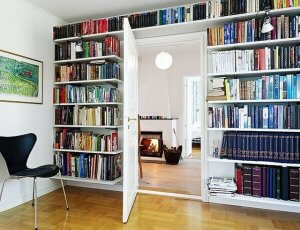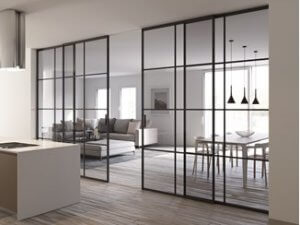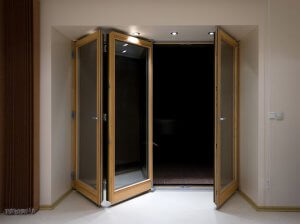Different Types of Door Mechanism

How much do you know about the different types of door mechanism? A lot? A little? Nothing? Don’t worry, we’ll tell you everything you need to know in this article, so you can make the right choice for your home.
Doors can generally be opened in one of two ways: by rotating around a vertical axis or sliding from side to side.
And it is from these two basic mechanisms that every other type of door originates. Today, there is a huge range of different doors on offer: hinged doors, double doors, sliding doors, swing doors and, to a lesser extent, rotating and folding doors.
Different types of door mechanism
Let’s take a look at the main characteristics of these different door mechanisms so that you can choose the one that best suits your home.
Hinged doors

Hinged doors are the most common type of mechanism. They swing open 90°, and are great insulators, keeping out both sound and drafts. Their main disadvantage is that they require around 30 inches of space.
From an aesthetic point of view, these doors offer up the greatest amount of variety. As they’re the most popular choice for homes, manufacturers have come up with a wide range of different designs, in all kinds of different styles.
Different types of door mechanism – double doors
Double or double-leaf doors usually measure around 46 inches. They help create a feeling of spaciousness, giving rooms a touch of elegance and formality.
They’re normally used for main entrances, although they can be used for larger rooms – ideally more than 215 sq ft in area. With their large, imposing presence, they’d look out of place and out of proportion in smaller rooms.
Sliding doors: beautiful and practical

The main advantage of sliding doors is that, by not having to rotate, they allow you to make the very most of your space. This makes them ideal for small rooms.
They’re often used to link closely related rooms such as kitchens and dining rooms, or bedrooms and dressing rooms.
These doors give a functional and dynamic space to any home. By simply opening or closing them, you can decide whether you want to separate or unite a space. There are three different types of sliding door:
Barn doors
This mechanism only requires a frame and a simple guide for the door to slide along the wall. The door isn’t hidden by the frame and moves parallel to the wall.
While they’re low-cost and easy to repair, they do have one downside – you won’t be able to use the wall the door runs along. This is an important point to keep in mind when it comes to installing these doors.
Pocket doors
With this mechanism, the door is hidden by a double wall of drywall or concrete. Drywall is simpler, but less solid, while concrete or bricks mean that any repairs will be more expensive.
Pocket doors with counter frames

Counter frames are metal structures concealed in the walls. When the doors are open, they slide into the counter frame. They’re easy to install and take up less space than normal partition doors.
Different types of door mechanism – swing doors
Swing doors have bidirectional hinges that allow them to open inwards and outwards. They’re really practical mechanisms for high traffic areas and are mainly used in kitchens.
To avoid any accidents, it’s best to have a porthole in the doors so you can see anyone coming from the opposite direction.
Swing doors can be single-leaf, double-leaf, or bat-wing “saloon” doors. Choose the one that best suits your needs and your style.
Pivot doors
These doors rotate 180° on a vertical axis, so that when they’re open, they create different aisles or paths, depending on the angle.
They’re not very common in homes and are mainly used for their great decorative potential. They take up a lot of space, so their use is restricted to homes with very spacious rooms.
Folding doors – a simple mechanism

These doors are made up of several panels that fold up and push to one side, just like an accordion. They work on a simple system of hinges and rails.
We recommend using them in smaller rooms where a standard hinged door would collide with furniture or the walls.
When open, they take up very little space, but when closed, they don’t create a barrier solid enough to keep out noise. One possible disadvantage is that many people don’t find them particularly stylish or aesthetic. That said, it’s all a question of taste.
So, now that you know all about the different types of doors, have you decided which would be best for your home?
How much do you know about the different types of door mechanism? A lot? A little? Nothing? Don’t worry, we’ll tell you everything you need to know in this article, so you can make the right choice for your home.
Doors can generally be opened in one of two ways: by rotating around a vertical axis or sliding from side to side.
And it is from these two basic mechanisms that every other type of door originates. Today, there is a huge range of different doors on offer: hinged doors, double doors, sliding doors, swing doors and, to a lesser extent, rotating and folding doors.
Different types of door mechanism
Let’s take a look at the main characteristics of these different door mechanisms so that you can choose the one that best suits your home.
Hinged doors

Hinged doors are the most common type of mechanism. They swing open 90°, and are great insulators, keeping out both sound and drafts. Their main disadvantage is that they require around 30 inches of space.
From an aesthetic point of view, these doors offer up the greatest amount of variety. As they’re the most popular choice for homes, manufacturers have come up with a wide range of different designs, in all kinds of different styles.
Different types of door mechanism – double doors
Double or double-leaf doors usually measure around 46 inches. They help create a feeling of spaciousness, giving rooms a touch of elegance and formality.
They’re normally used for main entrances, although they can be used for larger rooms – ideally more than 215 sq ft in area. With their large, imposing presence, they’d look out of place and out of proportion in smaller rooms.
Sliding doors: beautiful and practical

The main advantage of sliding doors is that, by not having to rotate, they allow you to make the very most of your space. This makes them ideal for small rooms.
They’re often used to link closely related rooms such as kitchens and dining rooms, or bedrooms and dressing rooms.
These doors give a functional and dynamic space to any home. By simply opening or closing them, you can decide whether you want to separate or unite a space. There are three different types of sliding door:
Barn doors
This mechanism only requires a frame and a simple guide for the door to slide along the wall. The door isn’t hidden by the frame and moves parallel to the wall.
While they’re low-cost and easy to repair, they do have one downside – you won’t be able to use the wall the door runs along. This is an important point to keep in mind when it comes to installing these doors.
Pocket doors
With this mechanism, the door is hidden by a double wall of drywall or concrete. Drywall is simpler, but less solid, while concrete or bricks mean that any repairs will be more expensive.
Pocket doors with counter frames

Counter frames are metal structures concealed in the walls. When the doors are open, they slide into the counter frame. They’re easy to install and take up less space than normal partition doors.
Different types of door mechanism – swing doors
Swing doors have bidirectional hinges that allow them to open inwards and outwards. They’re really practical mechanisms for high traffic areas and are mainly used in kitchens.
To avoid any accidents, it’s best to have a porthole in the doors so you can see anyone coming from the opposite direction.
Swing doors can be single-leaf, double-leaf, or bat-wing “saloon” doors. Choose the one that best suits your needs and your style.
Pivot doors
These doors rotate 180° on a vertical axis, so that when they’re open, they create different aisles or paths, depending on the angle.
They’re not very common in homes and are mainly used for their great decorative potential. They take up a lot of space, so their use is restricted to homes with very spacious rooms.
Folding doors – a simple mechanism

These doors are made up of several panels that fold up and push to one side, just like an accordion. They work on a simple system of hinges and rails.
We recommend using them in smaller rooms where a standard hinged door would collide with furniture or the walls.
When open, they take up very little space, but when closed, they don’t create a barrier solid enough to keep out noise. One possible disadvantage is that many people don’t find them particularly stylish or aesthetic. That said, it’s all a question of taste.
So, now that you know all about the different types of doors, have you decided which would be best for your home?







